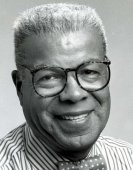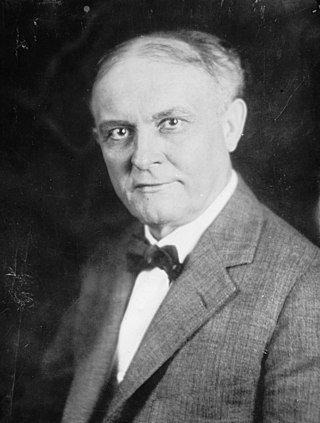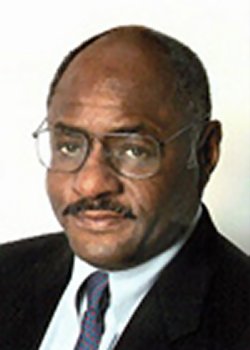
Charles Sumner "Chuck" Stone, Jr. was an American pilot, newspaper editor, journalism professor, and author. He was a member of the Tuskegee Airmen during World War II and was the first president of the National Association of Black Journalists, serving from 1975 to 1977. Passionate about racial issues and supportive of many liberal causes, he refused to follow any party line, "but called the issues as he saw them."
The National Association of Black Journalists Hall of Fame is a hall of fame project of the National Association of Black Journalists (NABJ) honoring African-American and other journalists. The original Hall of Fame list was established on April 5, 1990, with the induction of seven individuals. No further individuals were inducted until the Hall of Fame was revived by the NABJ in 2004. Since 2004, several individuals have been inducted to the Hall of Fame each year. Nominations are approved by the NABJ Board of Directors, and new inductees are installed annually at the NABJ Hall of Fame Banquet and Inductions. Thirty-nine individuals are currently inductees in the Hall of Fame.

The Akron Beacon Journal is a morning newspaper in Akron, Ohio, United States. Owned by Gannett, it is the sole daily newspaper in Akron and is distributed throughout Northeast Ohio. The paper's coverage focuses on local news. The Beacon Journal has won four Pulitzer Prizes: in 1968, 1971, 1987 and 1994.
The National Association of Black Journalists (NABJ) is an organization of African-American journalists, students, and media professionals. Founded in 1975 in Washington, D.C., by 44 journalists, the NABJ's stated purpose is to provide quality programs and services to and advocate on behalf of black journalists. The organization has worked for diversity and to increase the number of minorities in newsrooms across the country.
The John S. and James L. Knight Foundation, also known as the Knight Foundation, is an American non-profit foundation that provides grants for journalism, communities, and the arts.

Charles Landon Knight was an American lawyer and newspaper publisher who represented Ohio in the United States House of Representatives from 1921-1923. His sons built his newspaper business into what would become Knight Ridder.

Gerald Michael Boyd was an American journalist and editor. He was the first African-American metropolitan editor and managing editor at The New York Times, after joining the newspaper in 1983 in its Washington, D.C. bureau. A controversy in 2003 about the reporting of Jayson Blair forced both Boyd and the executive editor, Howell Raines, to resign that year.
Gregory L. Moore is an American journalist who was editor of The Denver Post from 2002 to 2016. Previously, he was managing editor of The Boston Globe.
Bryan Monroe was an American journalist and educator, who was the editor of CNNPolitics.com (2011–15). He was previously the vice president and editorial director of Ebony and Jet magazines at Johnson Publishing Co, and assistant vice president of news at Knight Ridder, where he helped to lead the team of journalists that won the 2006 Pulitzer Prize Gold Medal for Public Service for coverage of Hurricane Katrina. During his career, Monroe also had academic positions at Harvard University and Northwestern University's Medill School of Journalism, and from 2015, held the Verizon Chair at Temple University's Klein School of Media and Communication.

Herb Boyd is an American journalist, teacher, author, and activist. His articles appear regularly in the New York Amsterdam News. He teaches black studies at the City College of New York and the College of New Rochelle.
John Collins Quinn was an American journalist and the former president of Gannett Company, and former editor-in-chief of USA Today.
Betty Winston Bayé , an African-American journalist, columnist, and former member of the editorial board for the Courier-Journal newspaper in Louisville, Kentucky, United States, and Gannett is a journalist, former host of The Betty Baye Show TV program, and author. She is a former Vice President of the National Association of Black Journalists and an inductee into its Hall of Fame.
Loren Frank Ghiglione is an American journalist, editor, and journalism educator and dean. He has worked as a part of journalism professionally for over 45 years, and was awarded the Ida B. Wells Award from the National Association of Black Journalists, as well as the Distinguished Service to Journalism History Award from the American Journalism Historians Association. In 2001 he decided to focus his career around education, working as a professor for universities such as Emory University, University of Central Florida, and Northwestern University.
Richard Prince is an American journalist for newspapers, including The Washington Post, and long-term columnist of "Journal-isms," formerly for the Robert C. Maynard Institute for Journalism Education, now on its own site, journal-isms.com. Prince won multiple awards during his career and is known for coverage about diversity in journalism. In 1972, he was a member of the Metro Seven group who protested racial discrimination at The Washington Post.
Moses J. Newson is an American journalist for the Baltimore Afro-American in Baltimore, Maryland. Newson was an African-American journalists and risked his life while reporting on the Civil Rights Movement.

Lee Thornton, is an American journalist and correspondent for CBS, CNN, NPR, and professor at Howard University and the University of Maryland. She was also the first African American woman to cover the White House. She was inducted into the National Association of Black Journalists Hall of Fame in 2013.
Lynn Norment, born in Bolivar, Tennessee, is an American journalist known for her 30 years of writing and editing Ebony Magazine in Chicago, Illinois, United States. She was inducted into the National Association of Black Journalists Hall of Fame in 2009.
Jay T. Harris, an African-American journalist; journalism educator at the Medill School of Journalism, Northwestern University in Chicago, Illinois; and chairman and publisher of the San Jose Mercury News in San Jose, California, United States. He is a self-described "journalistic traditionalist" and stepped down as publisher as a statement about how the newspaper industry's emphasis on profits was harming its public mission. He was inducted into the Hall of Fame of the National Association of Black Journalists in 1992.
Rochelle Riley is the Director of Arts and Culture for the City of Detroit. She formerly was a nationally syndicated columnist for the Detroit Free Press in Detroit, Michigan, United States. She was an advocate in her column for improved race relations, literacy, community building, and children.
Acel Moore was a long-time reporter, columnist, and editor for The Philadelphia Inquirer. Moore won a Pulitzer Prize in 1977. He was among the first Black journalists hired at the Inquirer.





